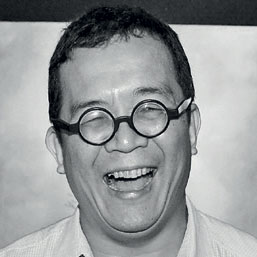Since the 1970s, street artists have been turning vandalistic cacography that appeared on many wall surfaces in around the big cities into more acceptable forms of expression. Gradually, what was initially known as graffiti became accepted as street art.
For the past 10 years, street art has continued to gain popularity, not only in the West. Art collectors in Asia also started looking into this urban art.
In 2009, Esti Nurjadin, owner of the Jakarta-based D Gallerie, met curator Alia Swastika, who then introduced her to Darbotz, a prominent name in street art in the Big Durian. The following year, D Gallerie presented its first graffiti exhibition featuring Darbotz, and since then it has held four exhibitions that featured other street artists.
Then last year, Nurjadin got to know Claire Tibauld Piton, an independent French art curator who had just moved to Jakarta. Soon, the two came up with the idea to bring French and Indonesian artists together in one exhibition.
“Both of us love graffiti so much. Claire had done a similar exhibition in Singapore with French and Singapore artists in 2011. We decided that graffiti has a lot of characters and it’s always fun to watch these artists perform,” Nurjadin said.
Partnering with Institut Français d’Indonésie (IFI), Nurjadin and Piton then held a major show entitled Off the Wall that was showcased at both D Gallerie and Museum Nasional. For the show together they picked five artists from Indonesia – Farhan Siki, Darbotz, Soni Irawan and Tutu – as well as five from France – Kongo, Fenx, Colorz Mist and Tilt. Some of the French artists had previously been to Jakarta for a graffiti exhibition at Salihara, in a show that was curated by Alia Swastika.
Famous Indonesian graffiti artist Darbotz picked up graffiti/street art in 2002 out of boredom. Abandoning paper, he then familiarized himself with Pylox spray paints. At Museum Nasional, he presented a work entitled Concrete Jungle, which depicted the convoluted hustle bustle of Jakarta. At D Gallerie, he created a work that seemed like fragments of street art that once existed on some wall in the city but was gutted out and instead be placed indoor.
Tutu, also from Indonesia, started spray painting since 2000, having picked up interest in the works of some students from the Jakarta International School, who painted on the walls of empty lots around Pondok Indah. Back then, the Internet was not as accessible as it is now, so Tutu had to learn the trick of the trade literally, from street artists.
“I realized that graffiti not only attracts people’s attention, and as it is present on the streets, it even somehow ‘forces’ people to view it. And interestingly, the public may not know who is behind the artwork. I think that is what makes me even more interested in this art form,” said Tutu.
His work Choose Your Mask is a social commentary about the different faces we wear in everyday life especially when we live in Jakarta. The artist enjoys making fun of the social culture of Indonesian both in real life and in their virtual lives on social media. In particular, he is most intrigued by the uber-present selfie phenomenon.
“A single selfie photo can cause controversy between haters and supporters. In my opinion, this cannot be separated from the character of many Indonesians who tend to want to interfere in the affairs of another person, even strangers. On the other hand, people keep posting their faces with different expressions to reap followers,” Tutu said.
To Darbotz, who had spent a year in Paris, the joint exhibition was quite an experience. It provided him a chance to reconnect with Kongo, Colorz and Fenx, with whom he had exhibited in the past. In Mist and Tilt, he admitted, he found his personal idols.
“To be able to meet them and create art together with them, seemed like a dream come true,” Darbotz exclaimed.
With Tilt, there’s always something new and exciting. Take, for example, Tilt’s idea for their collaborative work at Yellohotel and another one at IFI, which was to consider each artist’s work as paper scraps – reminiscent of Paris Metro stations that are commonly filled with posters that are frequently changed, ripped out or superimposed one on top of the other. It is, all in all, a reflection of the dynamism of urban life and culture in the city.
“By far, this is the most challenging exhibition that I’ve ever organized. Mainly because there are so many people involved, the sponsors, the French Embassy, IFI, Museum Nasional, the catalog designer and ten artists located between Yogyakarta, Paris, Tokyo, Jakarta and Montpellier. Another thing was the language barrier. Having to communicate in French, Bahasa Indonesia and English with everyone has been very challenging,” said Nurjadin.
Following the show at Museum Nasional, Nurjadin is now planning to bring more graffiti art to other museums in the Kota Tua district. “I’m imagining it to be more like a graffiti festival with hip hop music and street food,” she said.
Off the city’s walls, now into the art galleries and museums and soon into historic districts and urban festivals, it seems that street art is on the verge of going viral.











